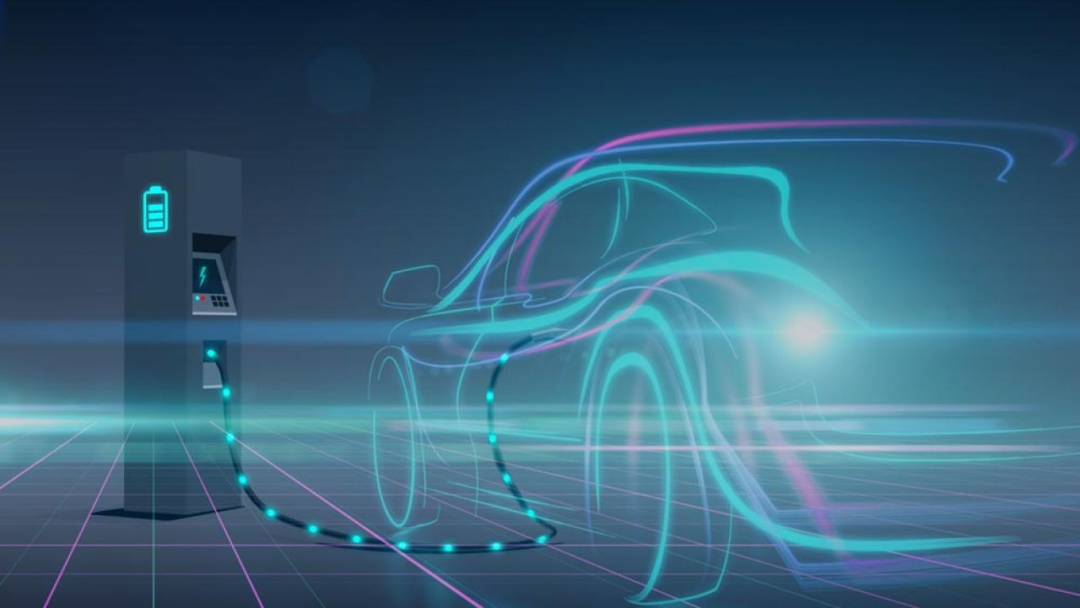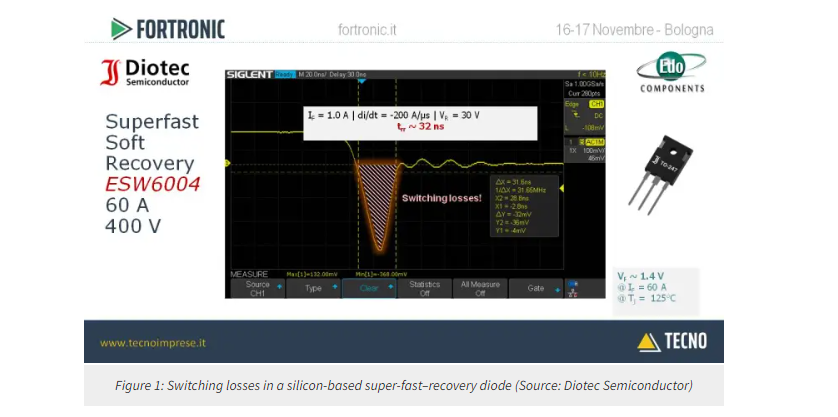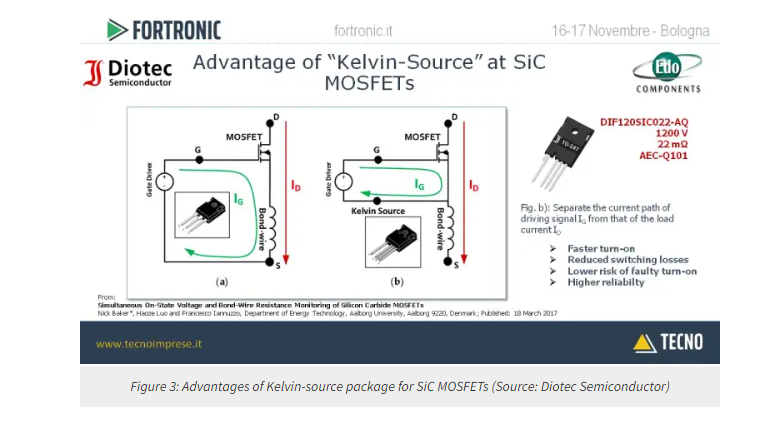
Diotec Semiconductor
Diotec, a European manufacturer of power semiconductors, was founded in 1973 in Heitersheim, Germany. Heitersheim, located in southwest Germany close to the borders of France and Switzerland, hosts Diotec’s headquarters, R&D, wafer, chip fab, assembly and global warehouse.
Diotec has a second plant in Slovenia, with wafer, chip fab and assembly capabilities. Other fully owned factories are located in India and China. All of Diotec’s factories are now equipped with solar panels, allowing the company to cover about 80% of its energy needs with its own independent energy sources.
Advantages of SiC-based power devices
Consider a day with abundant sunshine, resulting in ample renewable energy production, such as through photovoltaic panels. This energy can be utilized while an EV is parked and connected to the charging system, effectively charging the battery. This surplus energy, perhaps about 80%, can still be retained when the driver arrives home in the evening. Upon reconnecting to the mains, this energy can be returned to the grid, providing power for home activities, such as lighting or watching TV. Bidirectional charging is indeed a valuable feature, and silicon carbide devices play a significant role in its efficiency.
The enhanced efficiency provided by silicon carbide can be attributed to its impact on magnetic elements. Charging batteries demand high currents, which typically necessitate large coils. To minimize size, the solution lies in elevating the switching frequency of the components. The challenge lies in maintaining a compact and streamlined design for charging systems, avoiding excessive bulkiness.
Diodes
To better understand why SiC holds an advantage, let’s examine a traditional silicon-based super-fast–recovery diode, as shown in Figure 1. Specifically, the ESW6004 is a 60-A 400-V fast-recovery diode with a reverse-recovery time of 32 ns. The characteristics of the transition from the on state to the off (blocking) state, denoted by the red hatched area in Figure 1, dictate the power losses. The switching losses can be substantial, and with an increase in frequency, these losses escalate, causing the device to generate excessive heat.

Examining a SiC device, like the SICW 40C120, a 40-A 1200-V SiC rectifier, reveals that the switching losses are nearly negligible, though not absent. This is depicted by the small peak in Figure 2, resulting in significantly lower losses compared with a silicon diode. This indicates that especially for extremely high switching speeds and frequencies, SiC devices are the superior choice.

Examining the forward voltage (VF) specifications for the two diodes, we observe that the SiC diode has a higher VF compared with the silicon diode (2.0V, as opposed to 1.4V), which is a drawback of SiC. This implies that, in cases of DC operation or low-frequency operation, seeking SiC diodes would be impractical, as traditional silicon devices present a better choice.
MOSFETs
When dealing with SiC MOSFETs, the goal is to operate at an extremely high frequency. At high frequencies, even minor inductances become problematic. This includes the bonding wire within the component and package, which, when dealing with very high currents and rapid switching speeds, can pose issues during the part’s activation.
The solution to this challenge is the Kelvin-source MOSFET package, as illustrated in Figure 3. This package incorporates a special source connection for driving the MOSFET. By separating the driving path from the power path, the advantage is that the MOSFET can be switched on faster, eliminating the impact of bonding inductance. Additionally, faster activation reduces the risk of faulty turn-on. When the part is turned off, it does so safely. Ultimately, this Kelvin-source MOSFET, especially at very high switching frequencies, proves to be a superior device when compared with traditional package configurations.

Bridge rectifier
Let’s examine a standard battery charger, such as the common wall box found in many households. Although the wall box is nominally rated at 3 kW, the typical power consumption is 1 kW. A key component of the wall box is the bridge rectifier. When using a GBU10K component in a 1-kW charger, it draws approximately 4 A from the mains. With a voltage drop of 0.98 V per diode and only two diodes conducting per half-wave, calculations show a power loss of 7.8 W in the bridge.
Diotec has introduced a new bridge rectifier, the GBU10K-LV, featuring a lower VF of 0.87 V. After recalculating, the overall power losses in the bridge are reduced to 6.7 W. Considering the widespread use of such wall boxes in our country homes, the total available market is currently about 120 million units. Assuming that 10% of these wall boxes are equipped with the new low-power bridge rectifier, our calculations reveal potential energy savings of approximately 58 million kilowatt-hours worldwide, simply by adopting a different bridge rectifier. This is quite an impressive result, and we are just talking about a single rectifier bridge.
Load-dump protection
Another crucial component for EVs is the load-dump–protection system. EVs have not only a high-capacity, high-voltage main battery but also a conventional 12-V battery that is used to power auxiliary systems, such as the infotainment system display, lights, wipers and more. This battery is also used to power the switch that connects and disconnects the high-voltage system when the car is turned on or off. For this reason, EVs can start cars with combustion engines using conventional cables and vice versa.
During a jump-start, there is a potential risk of a phenomenon known as “load dump,” which involves the generation of a transient voltage spike when the battery is disconnected while the alternator is connected. This voltage peak, which can reach about 100 V, puts the vehicle’s electronics at risk. For this reason, every EV must be equipped with protection against load dump.
The load-dump–protection diode typically limits this voltage peak to approximately 35 V, which is within the acceptable range for the vehicle’s electronics. Diotec offers load-tamper–protection devices, including the LDP01 with a peak pulse power capability of 4.6 kW, the LDP02 (5 kW) and the LDP03 (6.6 kW), including the LDP01 with a peak pulse power capability of 4.6 kW, the LDP02 (5 kW) and the LDP03 (6.6 kW), currently in the development phase. All these components come in the industry-standard TO-263AB package, whereas most devices in the market are available in the DO-218 package. The TO-263AB package holds the advantage of being produced in large volumes, leading to a significant cost reduction.
ESD protection
When we talk about load-dump–protection devices, we have to introduce a similar item: ESD protection. During winter, when the air is dry, if we go to our car and touch the handle, we can get an electric shock. For human beings, it is not a problem; it’s just a little shock. However, for the electronics, it might be a serious issue, as this ESD can destroy the electronics. Regarding the charging cable, we have to touch it, which poses the risk of creating an ESD discharge to the electronics of our EV charging system, and that has to be avoided.
Diotec offers two components with integrated ESD protection. The MMFTN620KD-AQ is a dual MOSFET with integrated gate-protection diodes. When there’s an ESD event, the device will not be damaged. The ESDALC208 is an ESD array that can be used to protect signal and data lines against ESD. These components should be used in EV charging electronics to avoid damage caused by ESD.
About US
Heisener Electronic is a famous international One Stop Purchasing Service Provider of Electronic Components. Based on the concept of Customer-orientation and Innovation, a good process control system, professional management team, advanced inventory management technology, we can provide one-stop electronic component supporting services that Heisener is the preferred partner for all the enterprises and research institutions.
